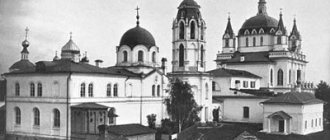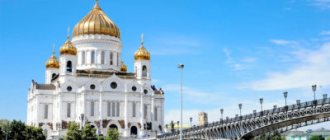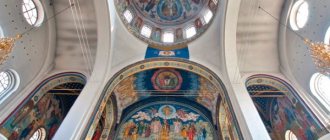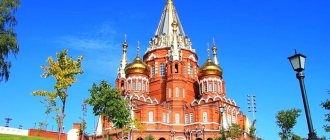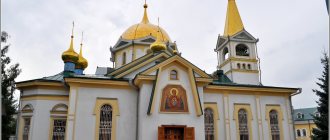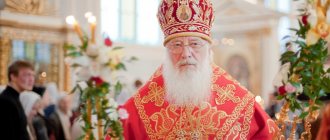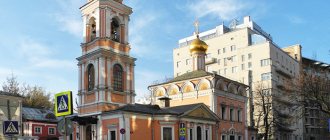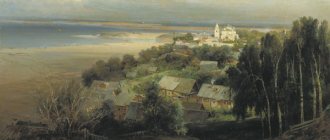"Save me, God!".
Thank you for visiting our website, before you start studying the information, please subscribe to our Orthodox community on Instagram, Lord, Save and Preserve † - https://www.instagram.com/spasi.gospodi/. The community has more than 60,000 subscribers. There are many of us like-minded people and we are growing quickly, we post prayers, sayings of saints, prayer requests, and timely post useful information about holidays and Orthodox events... Subscribe. Guardian Angel to you!
One of the greatest Orthodox monuments in Russia and the world is the Trinity Cathedral, Podolsk, the sermons delivered in it are a stronghold of the history of the city and the Christian culture of the entire country and are distinguished by their spiritual fullness and special meaning. Read more about the history and facts related to this “miracle” of Christianity later in the article.
The story about the Trinity Cathedral in Podolsk
The history of the cathedral dates back to August 1818, when local residents turned to the Moscow Archbishop with a request to build a new temple. People wanted it to be built in honor of the victory of their people in the Patriotic War of 1812.
The temple was built quite slowly, but gradually, because everything depended on material investments, which, unfortunately, were not enough. Construction of the cathedral began in 1820 and only in September 1825 the chapel of the Dormition of the Mother of God was officially consecrated, and in 1827 the main construction work came to an end, but the interior decoration and completion of the installation of the bell tower remained a matter of future times. The consecration of the main altar took place already in 1832.
The best article for you, go to: Nikolo-Ugreshsky Monastery where it is located, how to get there, address, schedule of services
Architecture
This structure has its own characteristics:
- belongs to the Empire style;
- consists of a main quadrangle, an altar apse, a refectory and a bell tower attached to it;
- the high central rotunda is cut through by small arched windows and completed with a dome with a dome and a cross in the form of a hemisphere;
- small drums standing at the corners of the quadrangle are also equipped with heads with crosses;
- on both sides of the quadrangle there are two Tuscan four-column porticoes with a pediment;
- the semicircular apse of the altar is dissected by flat pilasters;
- the entire building is surrounded by a stucco frieze;
- picturesque bright images are neatly arranged on the facades;
- the three-tier bell tower has a very rich stucco design;
- the walls are made of brick;
- the base, columns and facade decor are white stone;
- the refectory, located inside, is divided by six pillars with ceilings made of cross vaults;
- the arch opening connects the refectory with the temple itself;
- The ceiling of the altar apse is flat, the walls inside are decorated with oil paintings.
Historical periods of the formation of Trinity Cathedral:
- 1882 - preparation for a new consecration after the renovation;
- 1897 - a decree was issued on the opening of a parochial school at the cathedral;
- September 1, 1898 – classes begin. For a long time the temple remained the center of education of Podolsk and all of Russia;
- 1914 - Princess Elisaveta Feodorovna visited the cathedral;
- 1921 – visit of the Patriarch of Moscow and All Rus';
- 1922 – confiscation of valuables was carried out;
- 1927 – permission was received to build a wooden gatehouse next to the temple;
- 1920-1930s – the ministry of priest Peter Voron, who was canonized as a saint in 2000;
- since 1930 the cathedral has become the only one operating in Podolsk;
- 1935 - development of the territory adjacent to the cathedral;
- 1982-1984 - restoration of internal frescoes;
- 2001 – visit to the temple by Patriarch Alexy II;
- 1991 – opening of a Sunday school at the cathedral;
- 2002 – creation of the Orthodox youth organization “Protos” on the basis of a Sunday school;
- 2005 - the bringing of the relics of St. George the Victorious for veneration.
The best article for you, go to: Temple of the Archangel Michael in Troparevo
Over the past few years, many different works have been carried out to restore the cathedral, but one thing has remained unchanged - righteous faith in the Lord, which is the basis of the spirituality of every person - from young to old. And I am immensely pleased with the fact that to this day the temple remains the most significant for the formation of the spiritual morality of modern youth.
Trinity Cathedral, Podolsk (1819)
| Patronal holiday Holy Trinity (transitionable) Abbot Archpriest Alexander Vladimirovich Ganaba, 1956 Side chapels Dormition of the Mother of God (August 28) of the Holy Apostles Peter and Paul (July 12) Address MO, Podolsk, Cathedral Square. d. 3a Telephone +7, Official website podolsk-sobor.ru |
About the temple
The history of the Trinity Cathedral of Podolsk began in August 1818, when the townspeople turned to the Archbishop of Moscow and Kolomna Augustine (Vinogradsky) with a request for the construction of a new temple: “... they unanimously decided to build a stone church again, a huge building, inside the city itself, on Red Square, in the name of the Life-Giving Trinity, with chapels: on the right side - in the name of the Dormition of the Mother of God, and on the left - in the name of the holy apostles Peter and Paul, on which there is quite enough area for the construction of a new church and the construction of houses of land for the clergy and clergy.” The pious Podol residents wanted the cathedral to be built in honor of the victory of the Russian people in the Patriotic War of 1812. The architect Osip Ivanovich Bove worked on the creation of the project for the new temple. On October 31, 1818, Archbishop Augustine signed the charter created by the temple. In June 1819, Metropolitan Seraphim (Glagolevsky) of Moscow and Kolomna was presented with a revised draft of the church. In the summer we started construction: laid the foundation and erected walls to the level of the windows. The work was carried out by local craftsmen, merchant Vasily Semenovich Streltsov. According to the contract concluded with him, the construction was planned to be completed no later than 1822, and the cost of all work, not counting materials, was 24,050 rubles.
Already in 1820, the available funds to continue construction were not enough and a collection of donations was started. For this purpose, a wooden chapel was erected near the temple under construction, on the square at the Bolshaya Serpukhov Road, which was replaced by a stone one in 1847; At the same time, stone one-story trading shops were built on church land. Despite the fact that fundraising continued in subsequent years, in 1824 the church was still not completed: “...it was completely finished, covered with iron, but all that remained was to put the domes on it, attach the porch, lay the floor and tickle the inside, the bell towers one first tier is folded.” Only on September 8, 1825, the chapel of the Dormition of the Mother of God was consecrated. By this time, the wooden iconostasis of the chapel was painted white, and the columns and carvings were gilded. The work was still far from being completed; The bells were temporarily hung on stone pillars located nearby. In 1827, the construction of the temple came to an end, but the interior decoration and completion of the bell tower remained a matter of the future. The parish's debt then amounted to 12,000 rubles. By 1831, the iconostasis of the central chapel was made; The consecration of the main (Trinity) altar took place in 1832.
Trinity Cathedral belongs to the architectural monuments of the Empire style. The building consists of a main quadrangle and an altar apse, a rectangular refectory and a bell tower attached to it. The central rotunda, rising above the main volume, is cut through by small arched windows and completed with a hemispherical dome with a dome and a cross. The small drums standing at the corners of the quadrangle also have heads with crosses. On the northern and southern sides of the quadrangle there are two Tuscan four-column porticoes ending in a pediment. The altar semicircular apse is dissected by flat pilasters. A stucco frieze encircles the entire building. There are picturesque images on the facades.
The three-tier bell tower has richer stucco decoration. Its lower tier is decorated on the north and south with three-column porticoes of the Tuscan order with pediments, and on the west - with four columns. Each of the four sides of the second tier is decorated with two columns. The third tier, separated from the second by a molded cornice, is decorated on four sides with columns of the Ionic order, above which there is a molded frieze, a cornice and a pediment with a tympanum. The bell tower ends with a dome with a dome.
The walls of the cathedral are made of brick; the base, columns and decorative elements of the facades are white stone.
Inside, the refectory is divided by six pillars, the spaces between which are covered with cross vaults. An arched opening connects the refectory with the main part of the temple. The ceiling of the altar apse is flat. The walls inside are decorated with oil paintings.
In 1866, cholera raged in Podolsk and the district. With the blessing of Metropolitan of Moscow and Kolomna Philaret (Drozdov), the Jerusalem Icon of the Mother of God was brought from Bronnitsy. The residents of Podolsk fervently prayed to the Most Holy Theotokos in front of this image, and the terrible epidemic stopped. In 1868, a copy of the icon was made for the Trinity Cathedral, which has survived to this day. During the celebrations dedicated to the 50th anniversary of the deliverance of Podolsk from cholera, two banners with the inscription: “From the residents of the city of Podolsk” were donated to the cathedral.
In August 1882, Trinity Cathedral was prepared for a new consecration after renovations carried out in it. The silver vestments and iconostasis were gilded, and the wall paintings, made by the Moscow artist Varlaam, were renewed. The consecration of the temple was performed by Bishop Alexy (Lavrov-Platonov) of Mozhaisk.
In 1884, Pyotr Ilyich Tchaikovsky attended the service at Trinity Cathedral. He was delighted by the harmonious singing of the choir, which consisted of local singers (the choir was led by P. D. Volkov): “A very good church, very decent singing and service.”
On November 22, 1897, the Moscow Spiritual Consistory issued a decree on the opening of a parochial school at the Trinity Church in Podolsk. Construction began in the summer of next year. On September 1, 1898, classes began. Thus, the long-standing dream of the clergy and parishioners came true: now children from poor families had the opportunity to receive an education. The school became widely known in the Moscow diocese. Congresses of teachers of parochial schools were held several times in Podolsk. In the post-revolutionary period, the school building was requisitioned; only in the early 1990s. it was returned to Trinity Cathedral. It now houses Sunday school classrooms. In the same building there is a baptismal church, consecrated in the name of the Hieromartyr Vladimir (Epiphany), Metropolitan of Kyiv and Galicia. In this church they not only baptize, but also hold services for disabled children with developmental disabilities.
On October 31, 1914, Grand Duchess Elisaveta Feodorovna visited the Holy Trinity Cathedral. The rector, priest Sergius Levkievsky, addressed her with a welcoming speech. Having venerated the revered Jerusalem image of the Mother of God and the icon of the apostles Peter and Paul, the princess went to the infirmaries at the city government and hospital. Later, at the zemstvo government, Elisaveta Fedorovna headed a meeting of the committee to provide assistance to the families of those called up for war and left Podolsk at 8 pm.
On August 12-13, 1921, Podolsk residents welcomed Patriarch of Moscow and All Russia Tikhon (Bellavin) in their city. He celebrated the all-night vigil and Divine Liturgy at Trinity Cathedral. Unfortunately, there is no detailed information about this event. Only a brief entry about the visit to Podolsk has been preserved in the saint’s liturgical diary and a letter from the authorized representative of the VI department of the IBSC M. M. Shmelev to the deputy head of the IBSC SO U. I. Pyukenen, which said: “... with permission for him [the patriarch] to leave Moscow, as recently in Podolsk [k], such an arrest, without giving anything to the matter at all, without becoming a measure of suppression of anything on Tikhon’s part, only gives him and all those who honor him the right and reason to consider Tikhon suffering, oppressed for the Orthodox faith, etc. .
On April 4, 1922, valuables were confiscated from the cathedral. More than 3 pounds of silver were exported.
In 1927, permission was received to build a wooden gatehouse, which can still be seen next to the temple.
In the late 1920s-1930s. Priest Peter Vorona, who was canonized in 2000, served in the Trinity Cathedral.
Since 1930, the Holy Trinity Cathedral has become the only functioning temple in Podolsk. Already in 1935, a decision was made to develop the territory adjacent to the cathedral. The work was carried out in the post-war period; tall buildings obscured the temple on both sides.
Between October 1982 and June 1984, restoration of the frescoes inside the cathedral was carried out. It was found that during previous updates the coloring and construction of some plots were greatly changed. For example, on the western wall under the Epiphany stage, restorers discovered the Transfiguration. The background color in all medallions was originally gold. The compositions placed on the vaults had an “ornamental gilded frame.” The picturesque decoration of the window openings was completely rewritten, and the “towels” in the style of the 17th century in the basement of the walls appeared only during the last restoration. All later entries from the frescoes were removed.
On September 9, 2001, Patriarch of Moscow and All Rus' Alexy II (Ridiger) visited the Trinity Cathedral.
In 1991, a Sunday school opened its doors at the cathedral, which helps people striving for faith, especially children, to become conscious Christians. Studying at school has a beneficial effect on the spiritual and moral atmosphere in students’ families and helps bridge the gap between the Church and society.
In 2002, the Orthodox youth organization “Protos” was created on the basis of a Sunday school.
In September 2005, the relics of the Holy Great Martyr George the Victorious were brought to the cathedral for veneration.
Over the past few years, a lot of restoration work has been carried out in the Trinity Cathedral: the gilding of all iconostases and icon cases has been renewed, icons have been restored, wall paintings have been washed; new bells are placed on the bell tower; All domes and domes are gilded.
Based on materials from the book “Shrines of the Moscow Region. Podolsk deanery." Semenov K.A., Podolsk.
Share:
Operating mode
The temple is always open to its parishioners. Schedule of services of the Trinity Cathedral in Podolsk:
- Monday – Saturday: from 7.00 to 17.00;
- Sunday: from 6.30 – 17.00.
The schedule includes morning and evening liturgies, all-night vigils, and also depends on church calendar dates. Address of the Trinity Cathedral in Podolsk: Moscow region, Podolsk, Cathedral Square, 3a.
God bless you!
